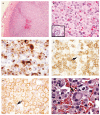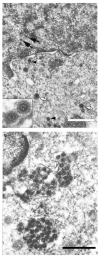Human herpesvirus-6-associated acute lymphadenitis in immunocompetent adults
- PMID: 15494709
- PMCID: PMC2288737
- DOI: 10.1038/modpathol.3800179
Human herpesvirus-6-associated acute lymphadenitis in immunocompetent adults
Abstract
In contrast to other causes of herpetic lymphadenitis, the histological features associated with human herpesvirus-6 (HHV-6) infection have remained elusive since its discovery in 1986. We describe the histologic and phenotypic changes associated with acute HHV-6 lymphadenitis in two immunocompetent adults who presented with fever, fatigue, generalized lymphadenopathy, and elevated liver enzymes. Serologic tests for human immunodeficiency virus, acute Epstein-Barr virus, and cytomegalovirus infection were negative. Lymph node biopsies were consistent with viral lymphadenitis. Intranuclear and cytoplasmic inclusions were identified in CD4-positive T lymphocytes in expanded paracortical areas. Immunohistochemical staining with monoclonal antibody to the HHV-6 gp60/110 kDa envelope glycoprotein showed that the inclusions were positive for viral antigen. Electron microscopy demonstrated numerous viral particles in the cytoplasm and nucleus, characteristic of Herpesviridae family. Clustering of viral particles was observed, which has previously been reported only in infected tissue culture cells. PCR followed by sequencing of DNA extracted from the lymph nodes identified the virus as HHV-6, type B. This is the first report that documents distinctive histologic features of HHV-6 lymphadenitis and demonstrates that the cells harboring the virus in vivo are CD4-positive T lymphocytes.
Figures


Similar articles
-
HHV-6-associated acute lymphadenitis in immunocompetent patients: a case report and review of literature.Int J Clin Exp Pathol. 2014 May 15;7(6):3413-7. eCollection 2014. Int J Clin Exp Pathol. 2014. PMID: 25031769 Free PMC article. Review.
-
Human Herpes Virus 6 (HHV-6)-associated Lymphadenitis: Pitfalls in Diagnosis in Benign and Malignant Settings.Am J Surg Pathol. 2018 Oct;42(10):1402-1408. doi: 10.1097/PAS.0000000000001121. Am J Surg Pathol. 2018. PMID: 29975251 Free PMC article.
-
Evidence for human herpesvirus-6B infection of regulatory T-cells in acute systemic lymphadenitis in an immunocompetent adult with the drug reaction with eosinophilia and systemic symptoms syndrome: a case report.J Clin Virol. 2014 Nov;61(3):448-52. doi: 10.1016/j.jcv.2014.08.025. Epub 2014 Sep 16. J Clin Virol. 2014. PMID: 25249343
-
A case of human herpesvirus-6 lymphadenitis with infectious mononucleosis-like syndrome.Pathol Int. 1995 Dec;45(12):947-51. doi: 10.1111/j.1440-1827.1995.tb03420.x. Pathol Int. 1995. PMID: 8808300
-
Is human herpesvirus 6 linked to kikuchi-fujimoto disease? The importance of consistent molecular and serologic analysis.South Med J. 2003 Mar;96(3):226-33. doi: 10.1097/01.SMJ.0000054420.01333.B0. South Med J. 2003. PMID: 12659352 Review.
Cited by
-
U94 of human herpesvirus 6 inhibits in vitro angiogenesis and lymphangiogenesis.Proc Natl Acad Sci U S A. 2009 Dec 1;106(48):20446-51. doi: 10.1073/pnas.0905535106. Epub 2009 Nov 16. Proc Natl Acad Sci U S A. 2009. PMID: 19918067 Free PMC article.
-
Concomitant Human Herpes Virus 6 and nivolumab-related pneumonitis: Potential pathogenetic insights.IDCases. 2018 Feb 8;11:101-103. doi: 10.1016/j.idcr.2018.01.013. eCollection 2018. IDCases. 2018. PMID: 29552493 Free PMC article.
-
Immunohistochemical diagnosis of human infectious diseases: a review.Diagn Pathol. 2022 Jan 30;17(1):17. doi: 10.1186/s13000-022-01197-5. Diagn Pathol. 2022. PMID: 35094696 Free PMC article. Review.
-
β-HHVs and HHV-8 in Lymphoproliferative Disorders.Mediterr J Hematol Infect Dis. 2011;3(1):e2011043. doi: 10.4084/MJHID.2011.043. Epub 2011 Oct 24. Mediterr J Hematol Infect Dis. 2011. PMID: 22110893 Free PMC article.
-
Detection of HHV-6 Virus in specimen of a ductal pancreatic adenocarcinoma with comparison in tumor and normal tissue.Diagn Pathol. 2023 Nov 14;18(1):124. doi: 10.1186/s13000-023-01402-z. Diagn Pathol. 2023. PMID: 37964347 Free PMC article.
References
-
- Yamanishi K, Okuno T, Shiraki K, et al. Identification of human herpesvirus-6 as a causal agent for exanthem subitum. Lancet. 1988;1:1065–1067. - PubMed
-
- Merelli E, Sola P, Barozzi P, et al. An encephalitic episode in a multiple sclerosis patient with human herpesvirus 6 latent infection. J Neurol Sci. 1996;137:42–46. - PubMed
-
- Akashi K, Eizuru Y, Sumiyoshi Y, et al. Brief report: severe infectious mononucleosis-like syndrome and primary human herpesvirus 6 infection in an adult. N Engl J Med. 1993;329:168–171. - PubMed
-
- Ablashi DV, Balachandran N, Josephs SF, et al. Genomic polymorphism, growth properties, and immunologic variations in human herpesvirus-6 isolates. Virology. 1991;184:545–552. - PubMed
Publication types
MeSH terms
Grants and funding
LinkOut - more resources
Full Text Sources
Research Materials

